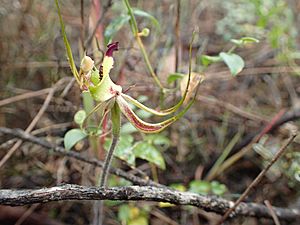Small mantis orchid facts for kids
Quick facts for kids Small mantis orchid |
|
|---|---|
 |
|
| Caladenia attingens subsp. gracillima growing near Jerdacuttup | |
| Scientific classification |
|
| Kingdom: | Plantae |
| Clade: | Tracheophytes |
| Clade: | Angiosperms |
| Clade: | Monocots |
| Order: | Asparagales |
| Family: | Orchidaceae |
| Subfamily: | Orchidoideae |
| Tribe: | Diurideae |
| Genus: | Caladenia |
| Species: | |
| Subspecies: |
C. a. subsp. gracillima
|
| Trinomial name | |
| Caladenia attingens subsp. gracillima Hopper & A.P.Br.
|
|
| Synonyms | |
|
Arachnorchis attingens (Hopper & A.P.Br.) D.L.Jones & M.A.Clem subsp. gracillima |
|
The small mantis orchid (scientific name: Caladenia attingens subsp. gracillima) is a special type of orchid. It grows only in the south-west part of Western Australia. This means it is endemic to that area.
This orchid is quite common. It has one upright, hairy leaf. It also grows one or two colorful flowers. These flowers are green, yellow, and red. The small mantis orchid is different from other similar orchids. Its flowers are smaller, and it grows further east.
Contents
What Does the Small Mantis Orchid Look Like?
The small mantis orchid is a ground-dwelling plant. It is also a perennial, meaning it lives for more than two years. It is a deciduous herb, which means its leaves fall off each year. This plant has a special underground tuber (like a small potato).
It grows a single hairy leaf. This leaf is about 80 to 160 millimeters (3 to 6 inches) long. It is also about 5 to 12 millimeters (0.2 to 0.5 inches) wide.
The orchid produces one or two flowers. These flowers are green, yellow, and red. They are about 50 to 70 millimeters (2 to 3 inches) long. They are also about 40 to 60 millimeters (1.5 to 2.5 inches) wide. The flowers grow on a stalk that is 170 to 350 millimeters (7 to 14 inches) tall.
Flower Parts
The orchid's sepals and petals have thin, brown, club-like tips. These tips are about 5 to 20 millimeters (0.2 to 0.8 inches) long.
- The dorsal sepal stands upright. It is about 35 to 45 millimeters (1.4 to 1.8 inches) long. It is also about 1.5 to 2 millimeters (0.06 to 0.08 inches) wide.
- The lateral sepals are about 35 to 50 millimeters (1.4 to 2 inches) long. They are about 2 to 3 millimeters (0.08 to 0.12 inches) wide. These sepals curve upwards and stay parallel to each other.
- The petals are about 25 to 35 millimeters (1 to 1.4 inches) long. They are about 1 to 2 millimeters (0.04 to 0.08 inches) wide. They are arranged like the lateral sepals.
The labellum is the orchid's special lip-like petal. It is about 12 to 16 millimeters (0.5 to 0.6 inches) wide. It is also about 15 to 17 millimeters (0.6 to 0.7 inches) wide. The labellum is green with a dark red tip. Its sides have small, narrow teeth. There are also four or more rows of crowded, red bumps called calli along its center. These calli even reach near the tip.
This orchid blooms from August to early October. It is special because its sepals are less than 3 millimeters (0.12 inches) wide. Also, its labellum is more than 15 millimeters (0.6 inches) wide.
How Did It Get Its Name?
The small mantis orchid was officially described in 2001. Two scientists, Stephen Hopper and Andrew Phillip Brown, gave it its scientific name. They published their description in a science journal called Nuytsia.
The subspecies name, "gracillima," comes from Latin. The word gracilis means "thin" or "slender." So, "gracillima" means "more slender." This name refers to the thinner sepals of this particular orchid.
Where Does the Small Mantis Orchid Live?
The small mantis orchid grows in the south-west of Western Australia. You can find it between Jerramungup and Israelite Bay.
It lives in areas known as the Coolgardie, Esperance Plains, and Mallee biogeographic regions. These regions are special areas with similar plants and animals. The orchid likes to grow near creeks, granite rock outcrops, and salt lakes.
Is the Small Mantis Orchid Safe?
The Western Australian Government's Department of Parks and Wildlife has classified Caladenia attingens subsp. gracillima as "not threatened." This means that currently, there are enough of these orchids, and they are not in danger of disappearing.

